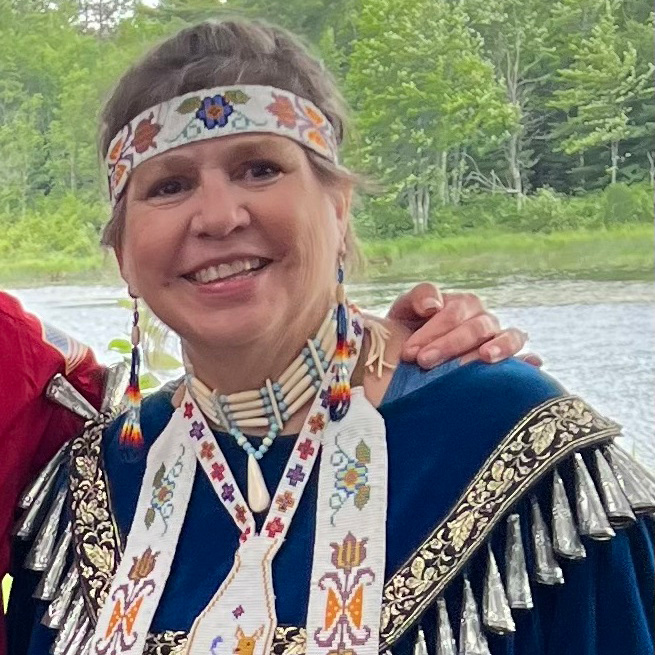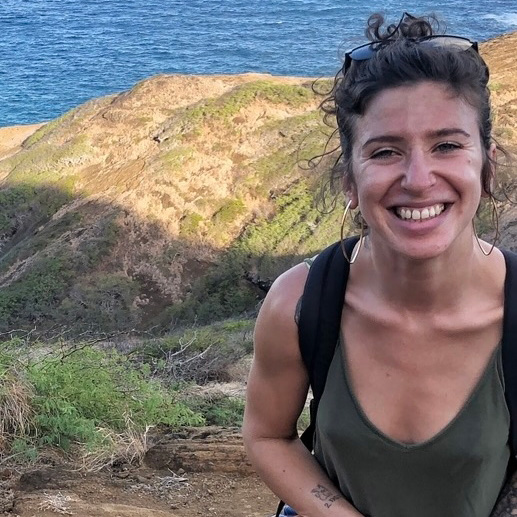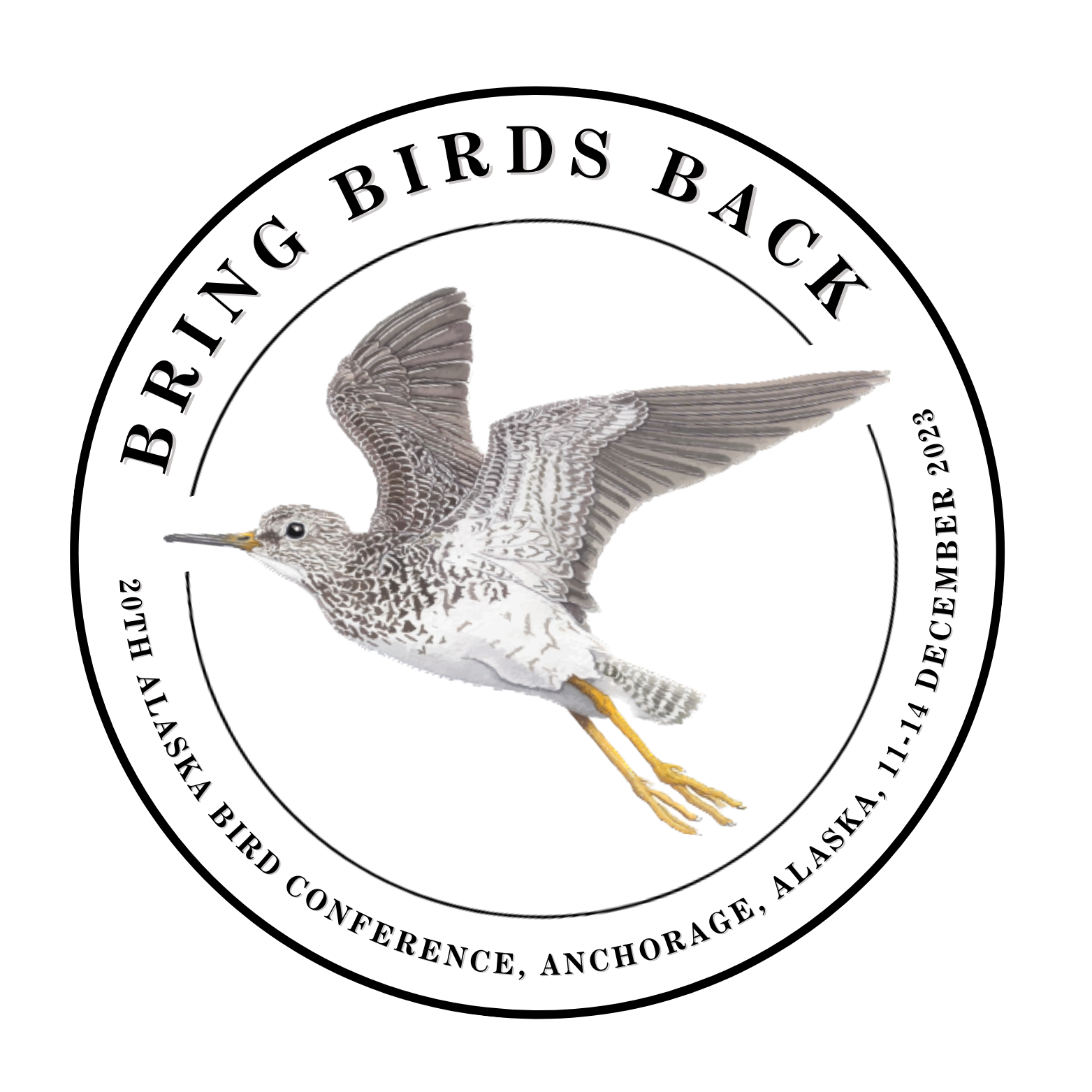Special Session: Indigenous Partnership in Bird Co-Stewardship
Presenters

Patty Schwalenberg
Patty Schwalenberg is Anishnaabe (Ojibwe), member of the Lac du Flambeau Band of Lake Superior Chippewa Indians in Wisconsin. She has worked with tribes across the country on natural resource program development and management for nearly 40 years. With a background in cultural anthropology, she works across cultures in partnerships including tribal governments, state, federal, and non-governmental organizations that utilize and honor all ways of knowing. She serves as the Executive Director of the Alaska Migratory Bird Co-Management Council.

Crystal Ciisquq Leonetti
Crystal Ciisquq Leonetti is the Alaska Native Affairs Specialist at the U.S. Fish and Wildlife Service, based in Anchorage. Crystal has a background in tribal consultation policy and law and assists USFWS staff and others on topics such as co-production of knowledge, Indigenous Knowledge, and cross-cultural communication. She helps to teach an annual Alaska Native Relations training to Department of Interior agency employees who work throughout Alaska and an Indigenous Stewardship course at Alaska Pacific University.

Christopher Tulik
Christopher Tulik is the Lead Refuge Information Technician for the Yukon Delta National Wildlife Refuge. Chris supervises up to five permanent RITs assisting the Refuge with outreach, education, and tribal consultation. Chris was born in Bethel and raised in Negtemiut, a Yup’ik village on Qaluyaat (Nelson Island). Growing up in a traditional subsistence way of life has given Chris an understanding of the importance of fish and wildlife to the culture of local Alaska Native people.

Willow Hetrick-Price
Willow Hetrick-Price is the Executive Director of the Chugach Regional Resources Commission (CRRC). She is responsible for the nonprofit Inter-Tribal Fish and Wildlife Commission, which is involved with natural resources, subsistence, climate change, environmental management and research, and related community economic development. A self-proclaimed bird nerd, Willow can identify 90% of Alaska’s songbirds by song and especially loves the thrushes in the summertime. She is thankful to the People of the Chugach for entrusting CRRC to tell the amazing stories of bird use throughout history to today.

Ram Papish
Ram Papish is a professional bird enthusiast whose varied career includes biologist, educator, photographer, and wildlife artist. As part of the Seabird Youth Network he has co-led Seabird Camp on the Pribilof Islands for the past 10 years. His interests include flowering shrubs, birdwatching, community theater, and world travel. His major achievements include appearing in the 2024 “Chicken Daddies” calendar.

Liliana Naves
Liliana Naves is an Oceanographer with a background in avian research. Since 2007, Lili has worked with the Division of Subsistence of the Alaska Department of Fish and Game. Her work blends natural and social sciences and has focused on bird harvest assessment, local and traditional knowledge, and outreach and education.

Claire Atkins
Claire Atkins is a graduate student in the Department of Natural Resources & Environmental Management at the University of Hawaiʻi at Mānoa. She is energized through collaboration, mutual support systems, and growing biocultural resilience in the context of climate change.
Presentations
Partners in Bird Conservation: Working with Alaska Native Tribes, Organizations, and the Alaska Migratory Bird Co-Management Council
Patty Schwalenberg, Wendy Loya, Ryan Scott, and Karen Pletnikoff
Alaska Native peoples have harvested and interacted with birds since thousands of years. In Alaska, subsistence refers to Indigenous ways of life centered on harvesting, sharing, and using wild resources for food, raw materials, and other cultural and traditional uses. Northern Indigenous peoples have traditionally harvested migratory birds in spring when other resources are scarce. The 1918 Migratory Bird Treaty Act (MBTA) outlawed harvest in March-August each year and did not account for subsistence uses. After decades of collaborative work, the MBTA was amended to allow the Alaska spring-summer subsistence harvest and a co-stewardship system was founded to collaboratively address topics related subsistence uses. The Alaska Migratory Bird Co-Management Council (AMBCC) includes the U.S. Fish & Wildlife Service, the Alaska Department of Fish & Game, and Native Caucus with representatives from ten regions. This presentation will overview Alaska Native peoples and their subsistence uses of birds, current management and conservation topics, types of information important to subsistence users, how the AMBCC and researchers interact, and some key partners. Finally, we will discuss successes and lessons learned from participating in a co-stewardship regime, where we rely on Indigenous and scientific knowledge for the successful conservation of migratory birds.
Co-Production of Knowledge and Healing: How Healing Catalyzes Positive Relations, Leading to Best Practices
Crystal Leonetti, George Yaska, and Mic Isham
A monumental apology was delivered to Alaska Native peoples in 2018 on behalf of the U.S. Fish and Wildlife Service and the Alaska Department of Fish and Game for the harm caused to Indigenous Peoples of Alaska during the 1960s and 1970s implementation of the Migratory Bird Treaty Act. It was an act preceded by an acknowledgement on behalf of State and Federal government agencies of the true stories so seldom if ever told in society at large. These past events, a story in nearly every Native family, echo on in memories, stories, and in the continued fear of wildlife agencies. Should the data rich Indigenous Knowledges become a part of current research, assessment, monitoring programs, decision-making, policy, and governance of Alaska’s bird stewardship, it is imperative that the management agencies become aware of the steps towards truth, reconciliation, and healing. Following these crucial trust building actions, the agencies and Indigenous peoples can take steps towards transforming bird research and management through best practices in co-production of knowledge.
The Refuge Information Technician Program: Native Liaison Supporting Indigenous Partnerships in Bird Co-Stewardship
Christopher Tulik
The US Fish and Wildlife Service in Alaska established the Refuge Information Technician (RIT) Program in 1983 to develop and conduct culturally appropriate outreach for geese conservation and recovery in southwest Alaska. RITs are local Alaska Native residents hired to disseminate management and conservation information to subsistence communities who remain dependent on birds and other wildlife and fish as food and cultural resources. RITs were instrumental in establishing bird harvest monitoring in rural communities. The RIT program’s successes in southwest Alaska led to its expansion to most Alaska refuges and RITs continue to play a crucial role in fish and wildlife conservation in rural Alaska. In this presentation, I will share experiences and knowledge of RITs as community and Native liaisons to support bird conservation, including practical steps for working with communities and tribal organizations on conservation issues, examples of what has and has not worked based on the RIT program’s 40-year history, and tips on how researchers and conservation organizations can engage with Yukon-Kuskokwim Delta communities moving forward. Finally, I will provide information on formal and informal cultural protocols to observe when working in Alaska Native communities, such as tribal council meetings, understanding local socio-economic contexts, and diverse communication styles that will allow more meaningful and productive engagements between conservation organizations and rural Alaskan residents.
Bird Traditional Knowledge and Ethnography in the Chugach Region
Willow Hetrick-Price, Brooke Mallory, and Priscilla Evans
Chugach Regional Resources Commission (CRRC) initiated a Southcentral Alaska Migratory Bird Wisdom Keeper’s Workshop to collect Indigenous Knowledge about migratory birds in communities in the Chugach region. The purpose of the workshop was to encourage Alaska Native participation in the science and management of migratory birds, increase awareness of management issues, and promote regional partnerships and coordination within the Chugach region and beyond. From this workshop, an immense interest in migratory birds has blossomed and CRRC has been developing an ornitho-ethnography intended for use by the communities and bird hunters of the Chugach region to assist in identifying various bird species and to understand traditional knowledge, uses, and beliefs regarding birds. We have compiled information from various sources (e.g., literature and Project Jukebox), interviews with Chugach leaders and elders, stories in which birds figure prominently, and oral history. The guide includes illustrations of bird species and related traditional knowledge and values. Transmission of Indigenous knowledge across generations has been historically disrupted, and more recently in the Chugach region due to interruptions in subsistence harvesting practices as a result of the 1964 earthquake and the Exxon-Valdez oil spill. Keeping Indigenous traditions and knowledge alive is important for the well-being of our communities. This project encourages Alaska Native youth to learn about traditional bird knowledge, hunting, and uses.
Pribilof Island Seabird Youth Network
Ram Papish, Ann Harding, Tonia Kushin, Alexis Will, and Kendra Bush
The Pribilof Seabird Youth Network (SYN) is a partnership between the Alaska Maritime National Wildlife Refuge (AMNWR), the Pribilof School District, St. George Island Traditional Council, Aleut Community of St. Paul Island Tribal Government, and the wider scientific community. This unique partnership provides youth (K-12 students on both Pribilof Islands) the opportunity to learn about the global importance of the seabirds breeding on the Pribilof Islands. The overall goal of SYN is to learn about seabirds while engaging and encouraging the scientific interests of local school kids. We use a multi-pronged approach that includes: winter school visits; cultural activities, theatre and art; internships for older students; a website platform; outreach for local seabird research projects, and annual Seabird Camps. 2023 was our tenth year of running Seabird Camp on St. Paul Island. This talk will share more about camp structure and focus, and what has been learned over the years.
Shorebirds for Today and Tomorrow: Culture- and Place-Based Learning at Schools and Communities in the Yukon-Kuskokwim Delta
Liliana C. Naves, Brenda L. Duty, Richard B. Lanctot, Alissa N. Rogers, and Lara F. Mengak
The Yukon-Kuskokwim Delta in western Alaska provides key habitat for millions of breeding and migrating shorebirds. To support Indigenous co-stewardship in shorebird conservation, we developed a youth outreach program that focused on shorebirds, the Yup’ik culture, and the environments of the Yukon-Kuskokwim Delta. The program relies on collaboration with local educators and communities. Shorebirds are an engaging topic to learn about healthy habitats, food chains, geography, and the diverse peoples that occur along their migratory routes. The content has a strong emphasis on Yup’ik culture and language including diverse activities and audio-visual and online resources. The program so far has reached about 1,800 youth in 14 communities. We will discuss insights learned from collaboratively working with local communities and schools. High turnover of educators in rural Alaska highlights the need for a dedicated communication plan. In-person interaction is needed for successful program implementation. Awareness of local socio-economic contexts is key to ensure that nature outreach and education programs are relevant among the many priorities and needs that communities in rural Alaska face.
Weaving Indigenous and Conventional Science in Shorebird Monitoring
Claire Atkins, Keliʻi Kotubetey, Hiʻilei Kawelo, Yoshimi M. Rii, Lee Tibbitts, Kawika Winter, and Melissa Price
Migratory shorebirds are declining worldwide, with serious implications for social-ecological systems. Indigenous stewardship, which is noted to facilitate an ability to sustain abundance of biocultural resources, could play a role in recovery of migratory shorebirds. Our co-developed research wove Indigenous science methodologies with those of conventional science, within the context of a biocultural restoration area, to understand patterns for five species of shorebirds who connect Alaska with Hawaiʻi through their migratory pathways: Kōlea (Pluvialis fulva); ʻŪlili (Tringa incana); ʻAkekeke (Arenaria interpres); Kioea (Numenius tahitiensis); and Hunakai (Calidris alba). A layered exploration of Indigenous observation methodologies from a loko iʻa (Hawaiian aquaculture system) and regional eBird data suggest: (1) decreases in juvenile recruitment of shorebirds across the Hawaiian Islands; (2) dissimilarities in ʻAkekeke over summering patterns between the loko iʻa and those of the eBird dataset; (3) environmental characteristics which support large/diverse assemblages of migratory shorebirds. Co-interpretation of data showed correlations between climatic shifts and the phenologies of seasonal anchor events. Our findings strengthen and inform stewardship, conservation, and management practices for shorebirds at both ends of the migratory pathway.
